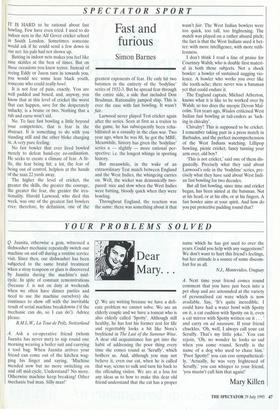SPECTATOR SPORT
Fast and furious
Simon Barnes
IT IS HARD to be rational about fast bowling. Few have even tried. I used to do indoor nets in the Alf Gover cricket school in South London. Sometimes someone would ask if he could send a few down in our net: his pals had not shown up.
Batting in indoor nets makes you feel like nine skittles at the best of times. But on these occasions you knew terror. Instead of seeing Eddy or Jason turn in towards you, you would see some lean black youth, someone who could really bowl.
It is not fear of pain, exactly. You are well padded and boxed, and, anyway, you know that at this level of cricket the worst that can happen, save for the desperately unlucky, is a bruise or two. Nothing that a rub and curse won't aid.
No. To face fast bowling a little beyond your competence, that is fear in the abstract. It is something to do with you standing still and the other bloke charging in. A very pure feeling.
No fast bowler that ever lived bowled merely to defeat hand-eye co-ordination. He seeks to create a climate of fear. A lit- tle, the fear being hit; a lot, the fear of being out of control, helpless at the hands of the man 22 yards away.
The higher the level of cricket, the greater the skills, the greater the courage, the greater the fear, the greater the irra- tionality. Harold Larwood, who died this week, was one of the greatest fast bowlers ever: therefore, by definition, one of the greatest exponents of fear. He only hit two batsmen in the entirety of the 'bodyline' series of 1932-3. But he spread fear through the entire side, a side that included Don Bradman. Rationality jumped ship. This is ever the case with fast bowling. It wasn't fair.
Larwood never played Test cricket again after the series. Seen at first as a traitor to the game, he has subsequently been reha- bilitated as a casualty in the class war. Two year ago, when he was 88, he got the MBE. Meanwhile, history has given the 'bodyline' series a — slightly — more rational per- spective: i.e. the longest whinge in sporting history.
But meanwhile, in the wake of an extraordinary Test match between England and the West Indies, the whingeing carries on. Well, the wicket was demonically two- paced: nice and slow when the West Indies were batting, bloody quick when they were bowling.
Throughout England, the reaction was the same: there was something about it that wasn't fair. The West Indian bowlers were too quick, too tall, too frightening. The match was played on a rather absurd pitch; the fact is that the West Indians used it bet- ter: with more intelligence, with more ruth- lessness.
I don't think I read a line of praise for Courtney Walsh, who is double first materi- al in both those subjects. Not a shock bowler: a bowler of sustained nagging vio- lence. A bowler who works you over like the tooth-ache; there never was a batsman yet that could endure it.
The England captain, Michael Atherton, knows what it is like to be worked over by Walsh; so too does the myopic Devon Mal- colm. Ten years ago, Wisden criticised West Indian fast bowling at tail-enders as 'lack- ing in chivalry'.
Chivalry? This is supposed to be cricket. I remember taking part in a press match in Barbados, and the perfect incomprehension of the West Indians watching. Lillipop bowling, picnic cricket, fancy turning your arm over, old boy?
`This is not cricket,' said one of them dis- gustedly. Precisely what they said about Larwood's role in the 'bodyline' series, pre- cisely what they have said about West Indi- an fast bowling for two decades.
But all fast bowling, since time and cricket began, has been aimed at the batsman. Not at his head, or at his ribs, or at his fingers. A fast bowler aims at your spirit. And how do you put protective padding round that?


















































 Previous page
Previous page